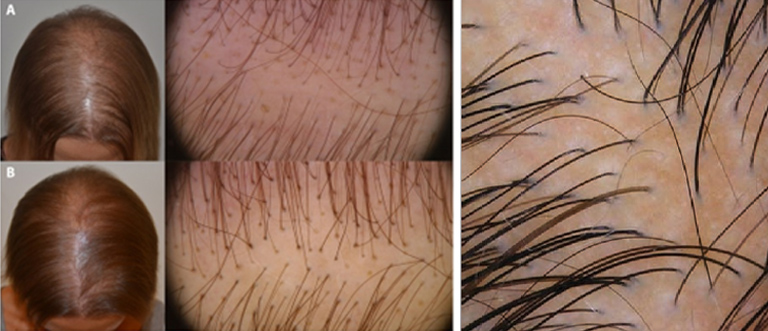So far, in our blog posts, we have predominantly covered hair treatment causes, solutions and details of the medications used for hair loss treatment. But guess what? There is more to what we do at L&P Aesthetics to ensure your scalp gets the best treatment to resume healthy hair growth. Hence in this publication, we will take a closer look at a method of hair examination used across the globe before treatment is recommended.
Tricho (Trichoscopic) analysis, also known as hair analysis or hair microscopy, is a diagnostic technique hair transplant specialists use to assess the condition of your hair and scalp. The procedure involves examining the hair strands and scalp under a microscope to gather valuable information about the hair’s structure, health, and potential causes of hair loss or other hair-related issues.
The tricho test involves collecting a small sample of hair from different areas of the scalp. These samples are then carefully examined under a microscope. Transplant specialists assess various hair quality parameters, including the hair shaft diameter, hair density, hair growth cycle, hair breakage, hair follicle health, and any scalp conditions or abnormalities.
Carrying Out the Test
Tricho analysis is typically performed by trained professionals, such as dermatologists, trichologists, or hair specialists, who have expertise in hair and scalp disorders.
Although the specifics of the techniques involved in a tricho test may vary depending on the healthcare professional and the hair treatment facility, it generally involves five to seven steps:
Sample Collection: The process begins with identifying scalp areas to collect the samples. These areas often represent the overall condition of the scalp or the regions most affected by hair loss or other hair-related concerns. The professional then extracts hair strands with the follicle using sterile forceps in a quick, smooth motion.
Sample Preparation: The collected hair samples are cleaned and prepared for microscopic examination. The professional removes any external debris, oils, or styling products that may interfere with the analysis. The samples are carefully handled to avoid contamination.
Microscopic Examination: The cleaned hair samples are placed on glass slides or specialized sample holders. The samples are then observed under a microscope with appropriate magnification and lighting settings. The professional examines the hair strands and scalp to assess various parameters.
Hair Shaft Analysis: The healthcare professional evaluates the hair shafts for diameter, thickness, texture, color, and structural abnormalities. These observations provide insights into the health, condition, and potential causes of hair loss or hair-related issues.
Hair Follicle Evaluation: The healthcare professional may also examine the hair follicles present in the samples. They analyze the hair follicles’ size, shape, and growth stage (anagen, catagen, or telogen) to understand the hair growth cycle and identify any abnormalities or disruptions.
strong>Documentation and Analysis: The professional documents their findings throughout the examination, taking notes and capturing images if necessary. This documentation serves as a reference for further analysis, comparisons, and future consultations or treatments.
Interpretation and Recommendations: Based on the tricho analysis findings, the healthcare professional interprets and discusses the results with the patient. They explain the potential causes of hair loss or scalp issues and provide personalized recommendations, including treatment options, lifestyle modifications, and hair care practices.
What the Tricho Test Tell Us
At L&P we have a technical partnership with dermatology clinics who provide our patients with accurate results that enable us to diagnose hair loss better. Here’s how we leverage it to help you overcome hair loss.
Hair Loss Type and Pattern: The test helps us identify the type of hair loss you are experiencing. It helps us identify and distinguish between different patterns, such as androgenetic alopecia (male or female pattern baldness), alopecia areata (patchy hair loss), telogen effluvium (excessive shedding), or other specific types of hair loss. Determining the pattern helps us set the foundation for our diagnosis.
Hair Density: A decrease in hair density or miniaturization, are common characteristics of certain hair loss. Evaluating the extent of miniaturization gives us insights into the severity and progression of hair loss. The test also enables us to measure the diameter of individual hair strands giving us crucial details about hair thickness which inturn enables us to identify nutritional deficiencies, hormonal imbalances, or genetic factors.
Scalp Condition and Inflammation: Tricho analysis helps detect signs of inflammation, redness, scaling, or other scalp disorders. The presence of scalp disorders dictates the prescription of relevant medications, altering the course of the treatment or the hair transplant procedure.
Microflora and Infections: Tricho analysis helps in the accurate detection of bacterial or fungal infections. Detecting scalp microflora imbalances or infections aids in recommending appropriate treatments to address the underlying cause of hair loss or scalp issues.
Treatment Efficacy and Progress Monitoring: After the test it completed, the results also serve us as a reference point to track changes in hair density, hair shaft quality, or scalp health and adjust the treatment plan if necessary. By assessing the progress, we can ensure the chosen treatment approach delivers the consistent results we promise to our patients.
Drop us a line today!
